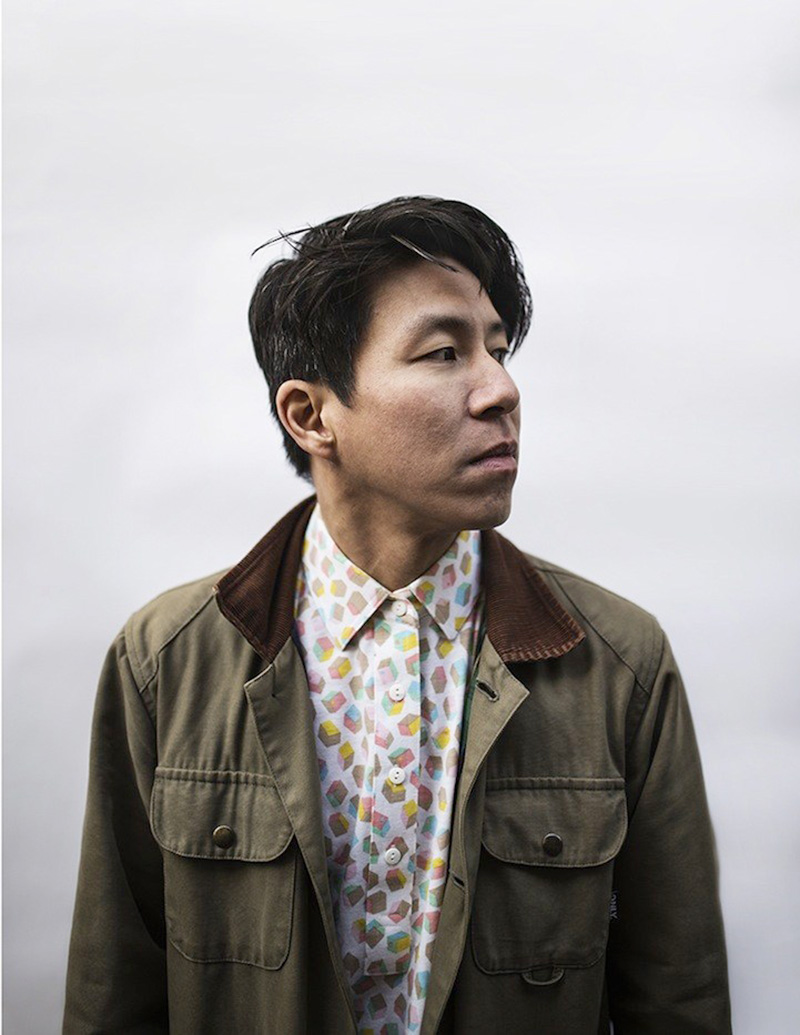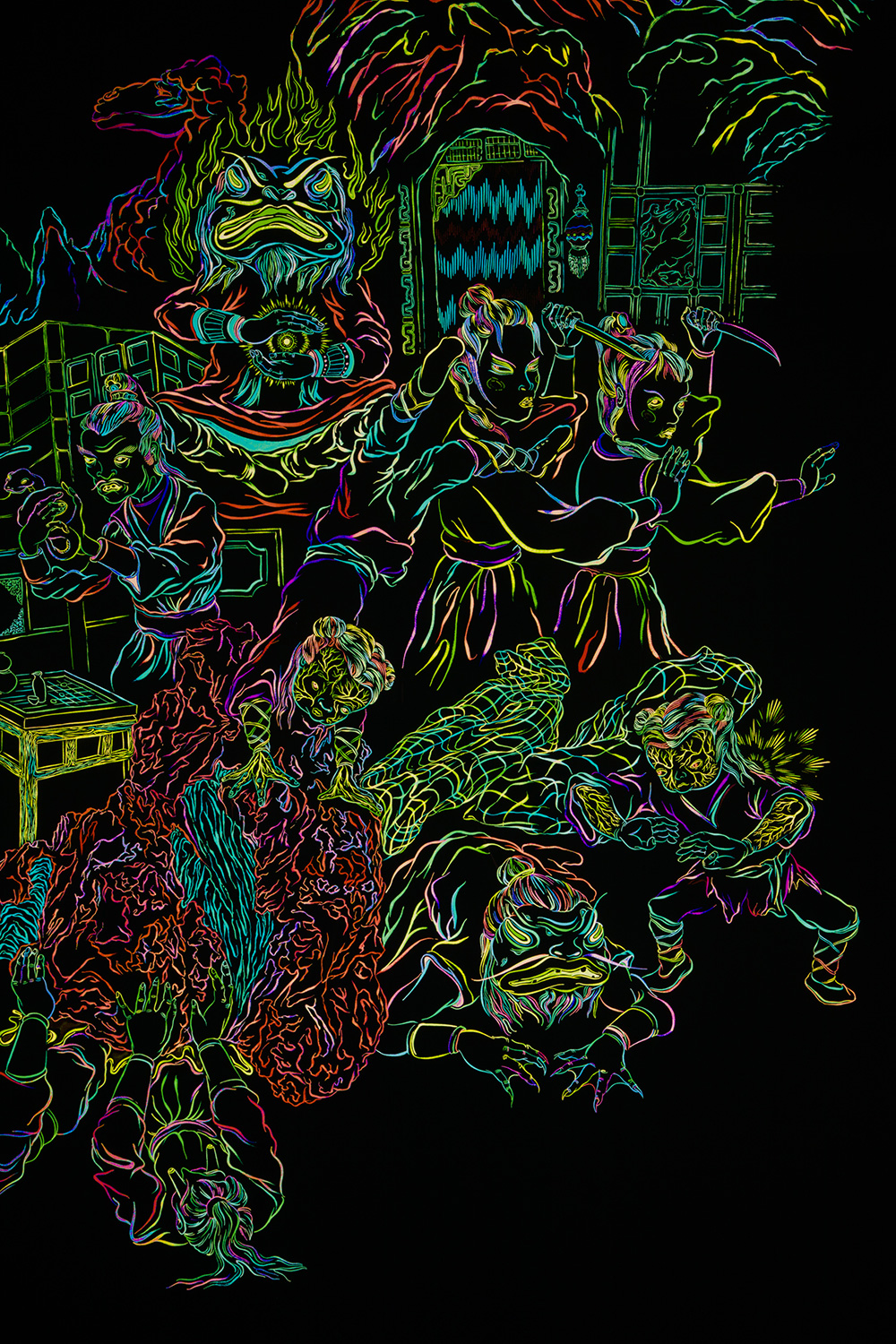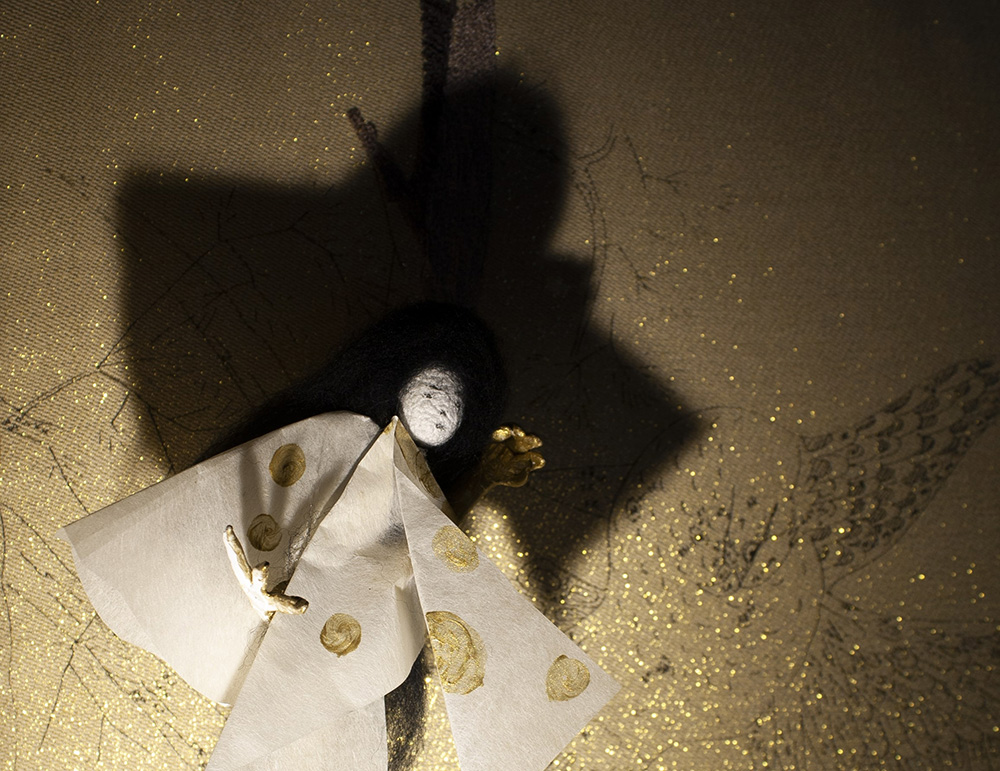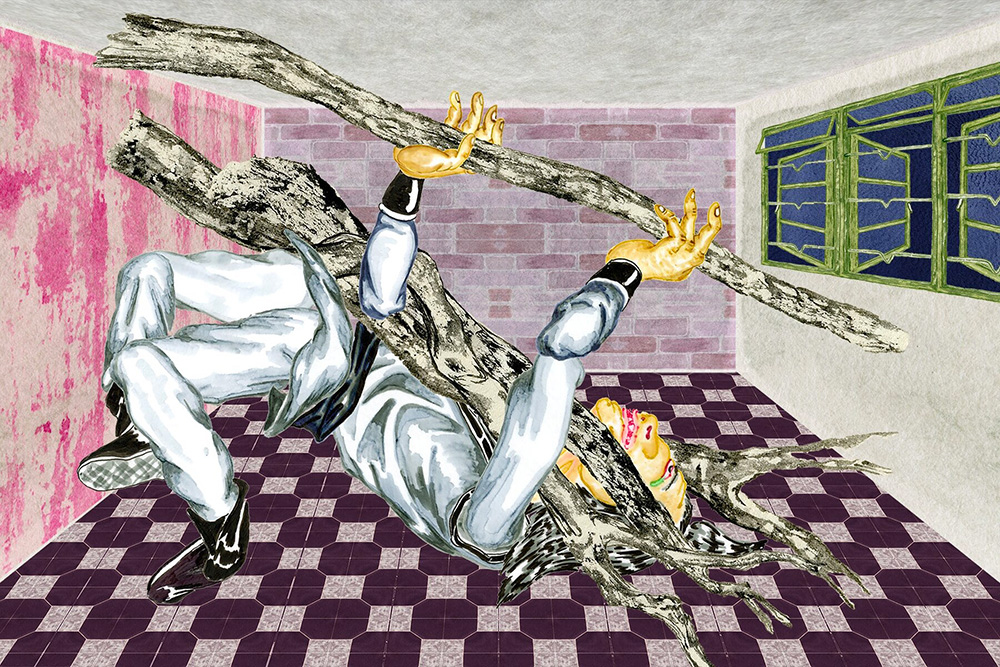Howie Tsui is a man of many talents — a great cook, a snappy dresser and, above all, an extraordinary artist. He uses the term “maximalist” to describe his aesthetic, which is an efficient way of conveying his many diverse influences — martial arts movies, the Hong Kong diaspora, manga, Kowloon Walled City, Transformers. It’s a long list.
Tsui was born in Hong Kong and started school in Lagos, Nigeria, before moving to Thunder Bay. His formative years were spent in northern Ontario, where the outsider status of T-Bay, with its heavy metal and bush parties, informed his creative outlook.
“Thunder Bay was a great place to grow up,” he told The Tyee. “I didn’t feel beholden to the dominant aesthetic or the metropolitan art crowd.”
But he felt the need to resist a different, more sinister pressure. It’s named in the description of his latest exhibit of work in Vancouver, where he now lives. What leaps out is a sentence about “the creeping suppression of voice and thought” endured by members of the Hong Kong diaspora.
It’s a conflict that has invaded familial relationships. Even Tsui and his family members argue about the protests in Hong Kong.
When Tsui first asked his mother, “Why did we move to Canada?” all he got was a vague answer about jobs. “But really, they didn’t know what was going to happen in Hong Kong,” he says.
Despite the decision to leave the city due to the looming handover, some family members have since been influenced by the Mainland Chinese position, watching social media videos that distort the protesters’ intentions.
“There’s a lot of kooky stuff in footage of the protesters; they add text, slow it down, add in menacing music,” Tsui explains. “It’s very manipulative.”
As someone who makes media, it’s easy for Tsui to understand how easy it is to manipulate images and videos. But older generations who aren’t quite as media savvy lack this critical eye.
The political divide between Tsui and some family has created difficulty in communicating clearly. “There’s an expression in Cantonese, chicken and duck talk. You claim to be talking to one another... ” he trails off.

Tsui’s collection of new work at the Burrard Arts Foundation is titled Parallax Chambers and evolved out of his earlier mega-installation Retainers of Anarchy. Retainers, which opened at the Vancouver Art Gallery in 2017, animated a 25-metre screen with wild characters and creatures drawn from wuxia films. The genre, based on the adventures of martial arts experts in ancient China, was banned for much of the 20th century.
Chambers shares with Anarchy a near-obsessive nostalgia for the media that Tsui grew up consuming, including video adaptations of Jin Yong’s popular wuxia novels of the Condor Trilogy.
Composed of Tsui’s fluid, almost squishy drawings mashed together with a huge dose of technology, the works in Parallax Chambers are eerily, almost disturbingly, alive. The gallery crawls with movement — giant condors flying through the air, spitting women, venomous snakes, frog monsters, Mahjong players gone full John Carpenter (a la The Thing). Tsui’s ink drawings have been transformed into sequential images, lenticular lightboxes and animation. It’s thrilling, strange and funny all at the same time.
The uneasy relationship between art and propaganda has been a consuming force in Tsui’s work since he visited Hong Kong on his honeymoon and took in the massive installation River of Wisdom, a 128-metre panel commissioned by the Chinese government in celebration of the 2010 World Expo.
River of Wisdom was a reinterpretation of Zhang Zeduan’s famous 12th-century scroll painting. In the modern update, the figures were adapted into 3D animation and made to move. On the surface, it was somewhat cheesy, but deep, strange currents are at work underneath. Namely, that the contemporary adaptation could be interpreted as anti-democratic propaganda.
In an interview with Canadian Art, Tsui explained his repulsion/attraction to River that evolved into Retainers of Anarchy, his own version of the scroll.
“First I thought, ‘Oh wow, major spectacle, mind boggled.’ But then I started sitting with it and thinking about what it portrayed: an idyllic, socially harmonious city. A deeper political, subtextual reading — this was a mainland China-produced spectacle in 2010, which then travelled to Hong Kong. And then I started to read it as some soft power messaging about how wonderful our city or society could be. Like, ‘this is traditional China; keep the harmony’ — especially at a time when Hong Kong was in turmoil, and in a position of being dispossessed.”
Although some elements featured in Parallax Chambers evolved directly out of Retainers, Tsui conceived the new suite of works as smaller pieces. But even work on a more limited scale comes with a thousand problems to solve.

“It was a risky and ambitious kind of thing,” he said. “There was a lot involved with the entire assemblage and getting it technically stable.”
One of the central motivations was to further explore the lawless, metastasizing urban experiment that was Kowloon Walled City. The self-organizing Hong Kong community was central to Retainers of Anarchy. Parallax Chambers breaks out eight different rooms inside the fabled Walled City, going into more depth and detail.
Although Tsui was too young to visit the place when he lived in Hong Kong as a child, Greg Girard’s book City of Darkness with its compendium of photographs and essays, proved enormously influential in Tsui’s work.
As a symbol of the resistance against Chinese authority, Kowloon Walled City looms large over the current protests in Hong Kong. Although it was demolished in 1994, its anarchic, ungoverned spirit lives on in Tsui’s extraordinary work.
Cindy Mochizuki on her ‘divination dolls’
As part of a 10-week residency program, Tsui worked next door to Cindy Mochizuki — in BAF’s purpose-designed studios in False Creek. This placed side-by-side two of the city’s most fascinating and wildly inventive artists; now their new work is on display at BAF along with that of Candice Okada, a terrific emerging creator.
Performance, family and memory all figure large in Mochizuki’s work. The installation in the BAF show — The Sakaki Tree, a Jewel, and the Mirror — is an evolution/development of those concepts, with an added cosmological element.
The title refers to a Japanese folk tale. Amaterasu, the Shinto Goddess of the Sun and the Universe gets into a fight with her brother (God of Sea and Storm). She has to be lured from her cave of mourning by three sacred objects — a jewel, a mirror and a sakaki tree.
In addition to 50 tiny figures, each attached to a long pole, the installation features beautifully embroidered oblong panels covered with roses, birds and foliage. Lit like a theatrical performance, the entire thing looks like it’s on the verge of spiralling into a wild-whirling dance.
Mochizuki, currently in Japan, answered Tyee questions about the nature and origins of the installation.
“When BAF approached me, they asked me to use the time in residence to experiment and try new ideas... I decided to use this time to just play and enjoy the play of materials. In the sense that the materiality of objects — long fleecy hair, silkworm faces, graphite, porcelain lead me to creating faces and figures.”

As part of the installation, a series of performances are planned, using the figures as “tools of divination.”
What does that mean, exactly?
“Aside from being an artist, I am a reader of fortunes. I have read tarot for over 20 years for many people all over the world,” Mochizuki explained. “The figures are divination dolls, meaning they each carry a symbolic meaning, and so the performances are for audiences of one that will select one of the figures.”
Each of the 50 figurines seems very different, with personalities (facial expressions and hair dos). Mochizuki says the process of creating each individual figure was an intuitive act.
“I decided to bring into the studio these bunka thread, canvases, mohair, wood, porcelain, clay and silk worm eggs (they came from Bulgaria — actually for another project but they were caught at the U.S. border and didn’t make the performance in time, so I used them for this project).”
Although the work doesn’t deal with her family history directly, her grandmother and aunt are present in the form of bunka embroidery (a traditional Japanese art form).
“My grandmother had a hobby of bunka embroidery, and she was extremely quick at finishing canvases well into her 80s.” The successive layers of cosmological myth, earthly materials and a dose of family imbue the work with a richness and depth, a distinct as a flavour.
The BAF show also includes Candice Okada’s Emergency Situation, which involves hundreds of hand-fashioned fabric sculptures and is accessible to audiences 24 hours a day as part of BAF’s Garage space.
Each of the works featured in the show is a powerful reminder that sometimes great things come in smaller galleries. New work from Howie Tsui, Cindy Mochizuki and Candice Okada is on display at the BAF Gallery (258 E. First Ave.) until March 7. ![]()

















Tyee Commenting Guidelines
Comments that violate guidelines risk being deleted, and violations may result in a temporary or permanent user ban. Maintain the spirit of good conversation to stay in the discussion.
*Please note The Tyee is not a forum for spreading misinformation about COVID-19, denying its existence or minimizing its risk to public health.
Do:
Do not: